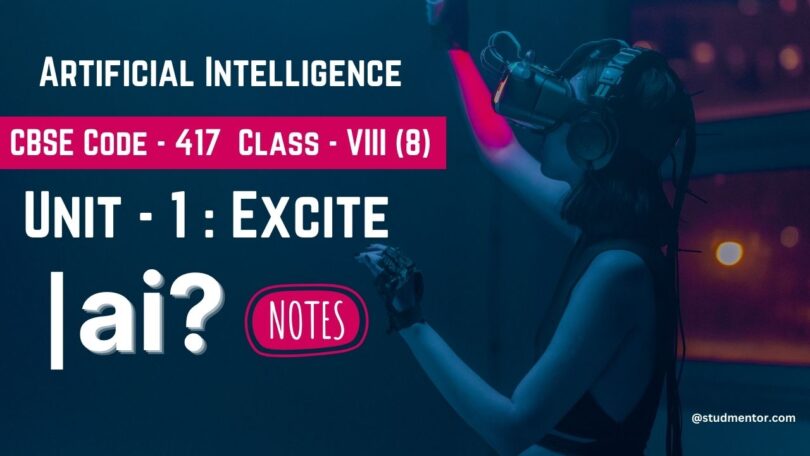Are you searching for – CBSE – Artificial Intelligence Class – 8 Unit – 1 Excite Notes 2023
Then you are at Right Place.
The Complete and Official Information of CBSE – Artificial Intelligence Class – 8 Unit – 1 Excite Notes 2023
CBSE – Artificial Intelligence Class – 8 Unit – 1 Excite Notes 2023
Here in this article will be covering First Unit – Excite.
So the first question comes to in our mind is
What is Artificial Intelligence ?
Artificial Intelligence made up from 2 words – Artificial and Intelligence.
Artificial – Made or produced by human beings rather than occurring naturally.
Intelligence – The ability to acquire and apply knowledge and skills, decision making.
Chapter – 1 : Introduction to Artificial Intelligence
The term Artificial Intelligence was first coined by Stanford researcher John McCarthy in 1956. In plain and simple words, the ability of a machine to think and learn is called artificial intelligence. The AI field refers to the study of the principles, concepts and technology for building such machines and systems that should think, act and learn like humans.
Machines possessing AI should be able to interact with their environment and perceive it through various stimuli such as visual perception, speech recognition, language comprehension etc. in the form of received data and respond to them, based on gathered intelligence.
According to McCarthy: “AI is the science and engineering of making intelligent machines.
Why Artificial Intelligence Today ?
Why artificial intelligence is a buzzword today in the field of computer science? The simple reason is that today we are technologically more advanced and ready to do better research and experiment in this field. We have computers with faster computational power, we have an enormous amount of data to process thanks to constant online presence of people, we have identified a number of important application areas where AI could prove extremely useful and we are now becoming able to program computers in much better way with complex and intelligent algorithms.
AI Challenges :
Having understood the traits of human intelligence, we can easily figure out the challenges posed in the path to achieving true AI. Some of the obvious challenges are to make machines who are able to do the following:
- Retain the facts as knowledge.
- Recall the knowledge in a situation.
- Think, analyse and apply logic.
- Make useful and accurate predictions.
- Make decisions and upgrade their intelligence algorithm themselves.
So, the biggest challenge is to develop a machine or a computer that can store knowledge and improve its own program to solve new problems with its evolved or improved intelligence.
Chapter – 2 : Artificial Intelligence : Types and Techniques
Artificial intelligence can be categorised in different ways. Two important bases on which AI can be categorised are:
- Complexity of intelligence
- Functionality
AI Types on the Basis of Complexity of Intelligence
Artificial intelligence that works with limited functionality and needs some prior information to be fed in order to accomplish a task is called weaker or narrow AI. On the other hand, any device or machine that is equipped with human-like intelligence is said to be showing strong AI.
Narrow or weak artificial intelligence
Machines that exhibit a limited extent of intelligence to accomplish a single, or certain simple tasks are said to have narrow/ weak intelligence. Such machines are deployed to perform some repeated tasks. Some examples are:
- Performing web-wide search of content (e.g. Google search)
- Recognising face among several single image shots or group images.
- Self-driven vehicles.
- Voice interface-based assistants such as Alexa and Siri.
- Any logic-based game such as a card game slot equipped with artificial intelligence loaded with the possible permutations of different sets of cards and rules of the game.
- A robot collecting empty food trays from the tables in a restaurant.
- A car driving simulator.
- A website suggesting similar products depending on the items bought by the user earlier.
Key features of narrow AI:
1. Perform a dedicated assigned task.
2. Limited to a particular field of application.
3. Has a predefined set of functions.
Strong or generalised artificial intelligence
Machines with strong intelligence are capable of not only “think” like humans but also able to retain the learning developed by the tasks accomplished. Such learned intelligence is used to solve the same problem in different scenarios. It is this type of intelligence which makes for the scope of actual AI to be developed in future. Such machines can be thought of having intelligence in the beginning like that of a child and later they learn and grow their intelligence like that of an adult. Some expected scenarios as an outcome of strong AI could be:
- A self-learning diagnostic system loaded with information regarding diseases and possible symptoms along with rules to diagnose the diseases.
- An airplane training system that functions without the help of a trainer.
- An intelligent chat-bot that understands customer’s needs and suggests solutions by its learned intelligence.
- A teaching robot that learns by answering students’ queries and thereby enhancing its teaching skills.
Key features of strong AI:
- Perform variety of tasks in changing context like responding to a question in different ways.
- Smart like humans. Think and respond like humans do.
- Capable of applying retained knowledge to solve new problems.
Contin…
Chapter – 3 and 4 we will discuss in Next Article.
Stay Connected.
Thanks to beloved Readers.


